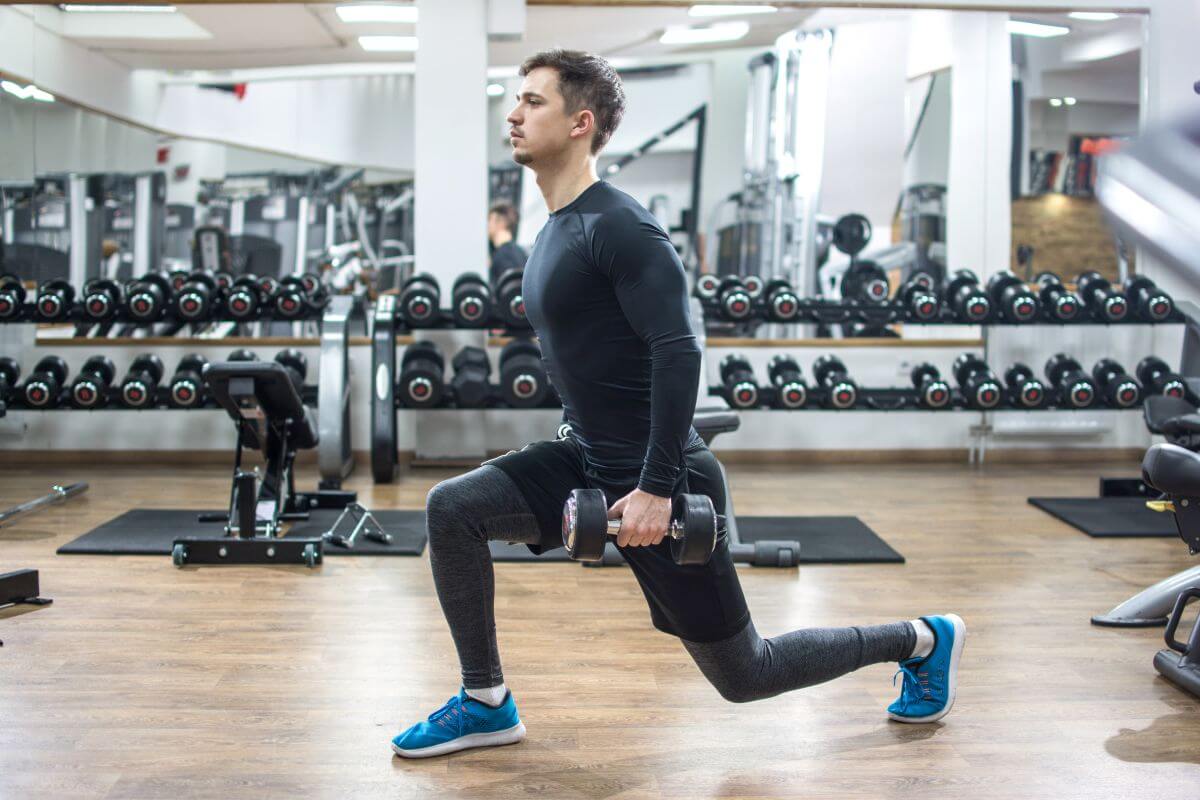I have a love/hate relationship with the dumbbell lunge.
I understand the importance of the exercise. It trains a foundation movement pattern known as the lunge.
But it is also one of the most technically demanding exercises one can possibly perform.
Essentially, it seems basic, but like how Shrek describes ogres, it’s like an onion. Let’s of layers of complexity to it.
In this expert guide, I hope to simplify that complexity for you.
I will explain how to perform the dumbbell lunge, what muscles it targets, how to add it to your workouts, and even provide some additional variations that you can look into if you wish.
How to Perform the Dumbbell Lunge
The dumbbell lunge is a dumbbell exercise that will require a set of moderately weighted dumbbells to perform.
To perform the dumbbell lunge:
- Select the dumbbells you would like to use to perform the exercise.
- Assume a stance with your feet a natural distance apart (about a foot’s worth). Stand with a proud chest and the dumbbells by your sides with a neutral (palms in) grip.
- Brace your core and shift the weight to the leg that will be your stance leg.
- Step forward with your other leg. It is important to maintain alignment through the ankle and knee, as well as throughout your hip complex, as you make this step forward.
- Plant the forward moving foot on the floor and raise the heel of your back foot.
- With your core braced and your spine neutral, lower your back knee towards the ground. Ensure you maintain contact between your feet and the ground by engaging all four corners of the front foot and the toes and pad of the back foot.
- Once you have lowered your knee to a depth slightly above the floor, press through the front foot to raise back up and return to the starting position.
- From here you can either alternate legs and perform for the desired number of repetitions, or finish the reps of one side prior to switching stance legs.
What Muscles Does the Dumbbell Lunge Target?
Dumbbell lunges are a compound exercise that will target several muscles groups when performed with proper form.
The primary muscles worked are the leg muscles. The emphasis will naturally be placed on the quads, but there will be a lot of involvement of the glutes, hamstrings, and calves.
Indirectly, the muscles of the core will be challenged to maintain a neutral spine and upright upper body. They will also be challenged in maintaining hip alignment throughout the step forward.
The muscles of the shoulders, forearms, and traps are also involved while you hold onto the dumbbells to perform the exercise.
Since so many muscle groups are involved, it is an excellent exercise to include in your workout routine assuming you are capable of performing the exercise with proper form.
How to Add Dumbbell Lunges to Your Workouts
The dumbbell lunge can be used as a primary exercise, secondary exercise, or accessory exercise depending on your goals for the exercise.
For that reason, the rep ranges can vary dramatically, and the weight used to perform the exercise can as well. A general recommendation would be to perform 2-5 sets of 6-15 repetitions. If you are treating it as a primary movement, stick to lower to moderate rep ranges. If you view it as your secondary exercise, consider performing moderate rep ranges. And if you view it as an accessory exercise, you can experiment with higher rep ranges.
You can add dumbbell lunges to nearly any workout routine. Again, its placement within your workout routine will depend on how you view the exercise.
Here are some ways to add dumbbell lunges to popular workout routines:
- At any point in a full body workout.
- During your lower body workouts in upper/lower splits.
- During leg day workouts in push/pull/leg workouts.
- During leg day workouts in bro split workouts.
Dumbbell Lunge Variations
The dumbbell lunge is a variation of the barbell lunge. The are many lunge variations that I will provide in this section so that you can look into them. Since the lunge is a foundational movement pattern, it is important to train it assuming you are in good enough health to do so.
That makes it important to find a variation that suits you and your goals. As I continue to write these exercise guides, I will link the variations below. In the meantime, feel free to search them in YouTube for further demonstration.
- Dumbbell reverse lunge
- Dumbbell split squat
- Bodyweight lunge
- Dumbbell lateral lunge
- Kettlebell lunge
- Dumbbell overhead lunge
- Front foot elevated lunge
Conclusion
The dumbbell lunge is a fantastic exercise to add to any workout. It is a very technical demanding exercise to perform. You may benefit from performing bodyweight lunges to really perfect your form prior to moving to a weighted version of the exercise.
It can be added to nearly any workout routine. If you are training strictly with dumbbells, it is a great movement to include in your dumbbell only workouts.
Reps and sets will vary as dumbbell lunges are a versatile exercise that can serve as a primary, secondary, or accessory exercise to your program.
If you enjoyed this exercise guide, please consider exploring the rest of the Legacy Muscle website and bookmarking it so that you remember to revisit. I am adding 100% human-generated content nearly every day and would love to continue to be part of your fitness journey!

Hello! I hope you’re having a great day. Good luck 🙂